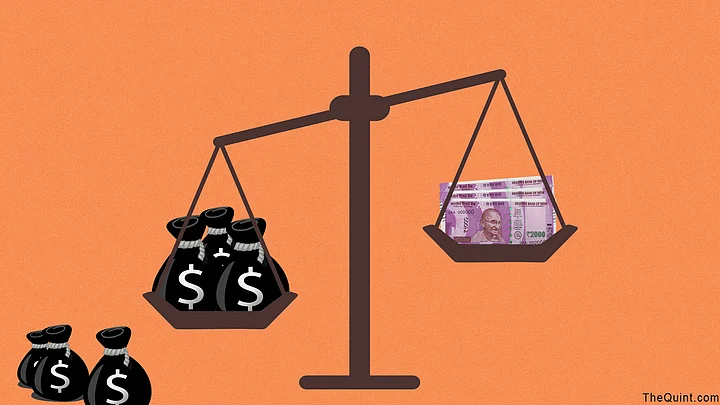Demonetisation, Debt, and Distress: Conversation between Raghav Bahl and Ravi Bansal
Raghav Bahl is the editor of The Quint and Ravi Bansal is JB Fuqua Professor of Finance and Economics at Duke University, USA and Research Fellow of the National Bureau of Economic Research USA.
New Tainted Cash
- If one assumes an amount equivalent to $50 billion can’t
be converted to alternative assets and goes to govt as tax, it will reduce the fiscal deficit.
- There are apprehensions that the tainted money will
be routed back to banks by misusing government schemes like Jan Dhan Yojana.
- Agra reported deposits worth Rs 170 cr in a single
day into various dead Jan Dhan accounts thus giving rise to a new way of money
laundering.
- Only major tax regulations will ensure that the
illegal cash economy doesn’t reappear in the form of Rs 2,000 notes.
Ravi: As you know, India demonetised. Several billion dollars worth of rupees will essentially vanish from the shadow (black) economy, due to the very tight window to convert the black money to some other valued asset. Let’s assume $50 billion worth of rupees are destroyed because they cannot be converted to alternative assets like gold or some other hard currency; this essentially is wealth tax on the holders of black money. What is remarkable, and less understood, is that it also writes-down (lowers) the debt of the government by the amount of notes destroyed by the demonetisation. If roughly 25 percent of the notes are not converted then the debt write-off is about $50 billion. That is about 2.5 percent of the Indian GDP!
Raghav: This is most interesting; the real problem is that all the tainted money will come back into the banking system, but largely in the form of “new tainted cash” – do see a report in TOI (dated 13 November 2016) about how in ONE day, Rs 170 cr has flowed into several hundred “dead Jan Dhan accounts” in just ONE city, Agra – now imagine what will happen over 5,000 cities/towns over 50 days – this is essentially a new way of money laundering. I’ve written a couple of pieces on this in the last two days on BloombergQuint.com or The Quint.com. So yes, what you are arguing below would be correct if the cash had to be destroyed; but if it comes back into new benami accounts, then you have just switched the black economy around – early evidence shows that that’s what’s happening. I would be delighted if you were to write your thoughts for us, though…
Also Read: PM Modi, Your Team Erred in Separating Demonetisation From VDIS
Ravi: I can see how Jan Dhan will raise the conversion to alternative assets. Nevertheless, the high denominations (Rs 500 and 1,000 notes) are about 85 percent of outstanding currency, which is about Rs 14 trillion (roughly 200 billion USD). I understand banks have collected already 22 billion USD of these denominations. We will see how much more comes back to all the banks. Even if 25 percent is destroyed, that translates to $50 billion or about 2.5 percent of GDP debt reduction. That is a significant amount of debt reduction.
The government needs to successfully enforce the law and disallow the fake conversions to build credibility. If they do so, they will raise their tax collections in the foreseeable future. India needs that revenue to fund infrastructure, education, and the rest.
Raghav: Yes, the key will be how much "black cash" is destroyed. If 25 percent gets destroyed, I would call it a success. But, if 22 billion got deposited in 2 days, then it is entirely conceivable that almost all of the 200 billion could get deposited in the next 48 days, in which case the whole plan would be a colossal flop, with an unnecessary shock to a slowly recovering economy. Let's watch for another 10-odd days. If the deposit frenzy continues, we could come pretty close to 200 billion. Let's see ... !
Also Read: Black Money Aftershock: Modiji, You Knew How Govt Machinery Works
Ravi: I am somewhat more optimistic; even if in the unlikely scenario all of the notes were converted back, the process would still enforce a wealth loss on the people holding cash in the shadow economy, as the conversion is not costless. They would still lose a significant amount in converting to gold, Jan Dhan accounts (reportedly up to 40 percent). In this case, it's just a wealth transfer from a rich shadow economy person to most likely a relatively poor person. This tax/loss is a fair and good outcome as these people are unfairly partaking of the government services without paying for them and free riding on the tax payers. The process of demonetisation has inflicted considerable distress on the common man – the silver lining to this is the debt reduction and greater future tax collections. Moreover, the additional money deposited back in banks could help growth if banks can loan more efficiently relative to the shadow economy.
Raghav: Agreed, but two points: one, the current shock to the economy, how much of a loss that would create? And unless major tax/regulation reform is done, the illegal cash economy will reappear pretty soon…
Ravi: Perhaps, but the current demonetisation will serve as a reminder that they face risks of an unexpected demonetisation, which should limit the re-accumulation of black money.
(At The Quint, we question everything. Play an active role in shaping our journalism by becoming a member today.)
